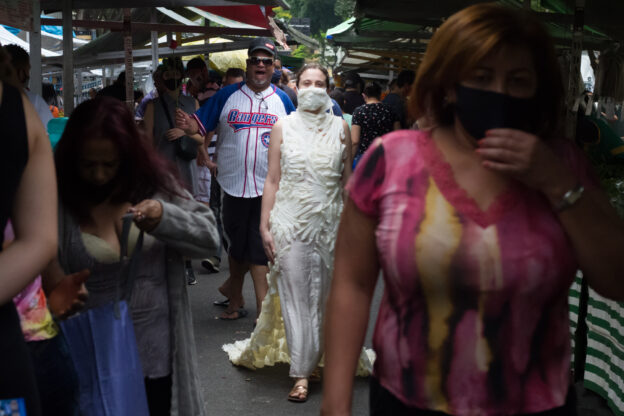Can you feel my pain? Unless it’s Star Trek and you are an Empath, probably not. Brazilian artist Nara Rosetto wants to make the invisible visible through performance art. She suffers from a chronic illness with no outward manifestations. She found that not only did others have difficulty understanding what she was feeling, some didn’t even believe her at all.
Our Remote Culture Journalism Intern Jisoo Seo had a chance to ask her some questions.
Nara fuses territories
Jisoo: How has your practice changed over time?
Nara: I started expressing myself only with textile art. Since the beginning the main subject was my body and my experience with the world, so with time I started using it as the “material” as well.
Jisoo: I am curious about your insight about the concept of ‘inside’ and ‘outside.’
Nara: For me both concepts coexist, like a Moebius tape. There is no inside without the outside and vice versa. Intimate subjects can also be public issues that connect us as humans beings
Jisoo: The performance video, protocolo de paramentação (2020), seems to challenge gender segregation. Please provide your existential experience about the background on how you started producing clothing and also about the performance.
Nara: This performance was actually really intuitive. It was my first time doing a piece of clothing and a performance all by myself. The dress was a remaking of an existing piece worn by my cousin at her debutant party 25 years ago. The action took place at a street market. The reactions were very intense and affected me in many ways – I felt electric, run-over, inspired and stuck at the same time
Jisoo: Nowadays, weaving works are widely used by multiple male and female artists, irrelevant to feminism, as a formative language. Despite this, the way you mediate textiles seems to be closely connected to gender characteristics. Historically, it is a woman’s handicraft, so it is related to women. Is there a special relativity between you and the weaving acts?
Nara: Yes, there is. My mom’s family has a long lineage of women (and also some men) which can connect to weaving – crocheting, sewing, embroidery, tailoring.
To me, textiles are a way to feel connected with them, while I also try to tell their stories through my own.
Jisoo: What kind of place does your body mean to you?
Nara: My body is the center of everything. It’s my main theme and issue at the same time.
Jisoo: Pra Quando o Carnaval Chegar (2021), Para mentation Protocol (2021) permeate into daily life and explores how everyday art creates a connection with place. The avant-garde prominently visualizes the problem awareness. This can be called a parasite-tactic that invades the communication path and applies an unexpected element to force the system to advance and also adapt. Can art change the world? What would be the ultimate value?
Nara: I don’t think that art alone can change the world, but It can be a seed that helps by expressing the spirit of time and bringing awareness to all sorts of problems. People can feel represented by it.
images supplied by artist
Jisoo: Due to the spread of COVID-19, the issues of inequality, discrimination, isolation, and violence faced by women in daily life are intensifying and accelerating. Accordingly, it requires ‘One Health’. In other words, humans, animals and nature all have to be connected for all to be healthy together and maintain the optimal state. If we are to arrive at a global concept based on the perception that everything, like the environment/economy/women, are all connected, we must deviate from the existing profit-centered values and discuss bringing about change. Mankind has entered into a chronic COVID-19 era, and you are sublimating chronic pain with art. If you were to envision an era of health worldwide, how should it take place?
Nara: My experience was to bring myself to exhaustion, a big burn out, for then listen to my body and make the changes that I needed to find some balance. I had the chance, support and privilege to do It.
Paraphrasing Louise Bougeois – “art is a guaranty of sanity”
While we continue to live in a place where profit comes before health and life Itself, we will continue to experience more and more chronic illness.
Jisoo: Please share what you would like to achieve as an artist through the online residency program and also your ambition and career plans for the future.
Nara: The residency gave me a huge opportunity to explore my practice further. We had a deep connection with the mentors, experts and other artists. I’m really grateful for our time. It gave me courage to risk, expose and believe in myself.
Later this year I’ll start a Fine Arts Master at Porto University!
written by Jisoo
Nara is currently participating in our online residency. Find out more about her work at her website, instagram.
blauverschiebung performance festival no.14
Galerie KUB
16-25 July
CLOSENESS
Nara will be performing via live-stream
18 kant Str
18 July 4PM-5PM
and on Zoom








